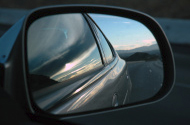How To Use Car Mirrors
Mirrors allow you to observe what is happening around your car. They are your most important visual driving aid, and are vital for safe driving.
Their purpose is to let you know what is happening behind, which is just as important as knowing what is happening in front. You must use your car mirrors frequently, and respond safely to what you see in them.
When Taking Your Driving Test
- Mirrors should be used regularly and the test candidate must be aware of the presence of others in their blind spots. Early use of mirrors should be made before signaling, changing direction, changing speed and as part of the mirror-signal-manoeuvre routine.
- When using your mirrors, do not take your eyes off the road in front for any length of time. A quick glance should be sufficient, if it is not, then a series of short glances is preferred to taking your eyes off the road ahead.
- The faster you are travelling the earlier and more frequent your mirror checks need to be.
- If you have to speed up, slow down, change direction, turn, indicate or stop, or if you are approaching any hazard that may cause you to do of these, you must check your mirrors.
Interior Mirror
Also known as the rear view mirror, This is usually a mirror made with flat glass which gives a true picture of anything behind you. The image reflected in such mirrors isn’t distorted, which makes it easier to judge the speed and distance of following traffic.
Most car mirrors have an anti-dazzle lever. This is for use at night so that you are not blinded by the glare of headlights from vehicles behind.

As with all car mirrors, only adjust the interior mirror when the car is stationary and you are seated in your normal driving position. Hold the mirror at the edges to avoid finger marks. Adjust the mirror so that you get the best possible view through the back window without having to move your head.
You should be able to frame the whole of the rear window in the interior mirror, but, if you can’t, make sure you can see the top right-hand side of the rear window.
Exterior Mirror
These are convex mirrors, which are made using curved glass. Convex mirrors give a wider field of vision, however, they make judging the speed and position of following traffic more difficult. Vehicles will appear smaller and further away than they actually are.
Adjust the exterior mirrors so that you can get the best rear view with minimal head movements. You should be able to see a small strip of the side of the car, and the horizon should appear about in the middle of the mirror.

Correctly Positioned

Too Much Sky

Too Much Car
Nearside and Offside
The nearside mirror is the one nearest the kerb, on the left-hand side of the car. The offside mirror is the one on the right-hand side.
Blind Spot
This is an area around your car that cannot be seen in your mirrors. The most dangerous of these are the blind spots behind your left and right shoulders, the area obscured by the bodywork of the car when you look in your side mirrors.

To counter these blind spots you should look over your right and left shoulders to observe the view through the side windows.
Sometimes you will need to check a blind spot whilst on the move such as when changing lanes on a dual-carriageway.
To do this glance quickly to the left or right. There is no need to turn and look right behind, as this is dangerous.
Using Your Mirrors
Regular use of your mirrors is an essential part of safe driving. You need to be aware of what is happening around you at all times.
When using your mirrors you should be asking yourself what’s behind you, how near they are to you, what speed they are travelling at and what their intentions are. You must have enough time to decide, which makes early use of the mirrors essential.
Which mirrors you use will depend on the situation and manoeuvre you intend to carry out. Normally, you should use the interior mirror first followed by the exterior mirrors.
Before carrying out any manoeuvre always check your mirrors. This includes:
- moving off – check all mirrors and look over your right shoulder to check the blind spot.
- changing lanes – check all mirrors and either the left or right blind spot depending on your direction.
- overtaking – check your mirrors paying special attention to the offside mirror to make sure no one is about to overtake you.
- turning left or right – check the interior mirror and the nearside mirror when turning left and the offside mirror when turning right.
- Slowing down or stopping – a vehicle following too closely may fail to stop in time when you brake. Check your mirrors in good time so you can lose speed more gently if necessary.
- leaving you car – check your mirrors and blind spot before opening the car door in case a vehicle is passing.
Approaching Hazards
- junctions
- bends
- pedestrian crossings
- road works
- slow moving vehicles
